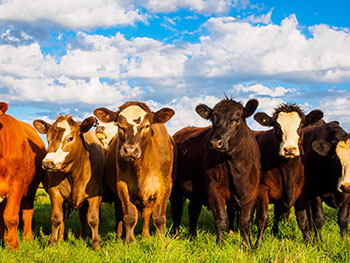Cattle Processing in an Unusual Year: Preventing COVID-19 Transmission

To promote human safety while performing necessary cattle management procedures during the COVID-19 pandemic, the following information is presented by the Alabama Cooperative Extension System, Alabama Beef Cattle Improvement Association, Alabama Cattlemen’s Association, Alabama Farmers Federation, and the Alabama Department of Agriculture and Industries, and adapted from material prepared by Colorado State University Extension, the Colorado Cattlemen’s Association and the Colorado Livestock Association.
Beef cattle production is an essential business in Alabama and critical to our nation’s food supply, so we need to work together to ensure that there are minimal disruptions to normal operations. During this pandemic, we encourage you to be a good neighbor and look for specific ways to manage your activities while minimizing the potential for transmitting human disease.
To help in that effort, and in light of rapidly changing gathering restrictions due to COVID-19, we have compiled the following cattle processing considerations and recommendations to minimize the risk of human-to-human disease transmission during these necessary management events.
Immediate Considerations and Questions
Can you safely and effectively accomplish all necessary cattle processing work within your immediate family/workforce? In other words, can you accomplish what you need to without needlessly involving people that you currently don’t have contact with regularly?
If you need to involve people that you don’t normally have contact with, can you delay cattle processing events until later into the summer when, hopefully, COVID-19 is less of a concern?
Can you decrease the number of people it takes to accomplish the task? For example, requiring that the squeeze chute operator conduct all the work associated with the animal in the chute (shots, tags, implants, etc.).
Recommendations
Pre-planning
Reduce the number of people who attend or help with cattle processing. Ask older adults, young children, and high-risk individuals to stay at home. While it is fun to involve multiple generations in cattle-working events, now is unfortunately not the time for that. Take extra precautions now so future cattle-working events can be enjoyed by all.
Set up multiple wash/sanitization stations and encourage frequent handwashing.
Set up processing or work groups that are social contemporaries or those who are already spending time together. Distance each working group from each other and don’t allow mixing of the groups.
Draw a plan of the work area and evaluate for efficiency and safety of workflow.
Advise your workers beforehand about the way the activity will be conducted. They should prepare and point out unintended flaws and take steps to correct these before the event.
Consider processing smaller groups of cattle over multiple days to use less help.
If you and your neighbors regularly work together, agree to limit the number of cattle processing events each person attends per week or 2-week period.
Remind workers to use personnel protective equipment (PPE) as needed. This will vary with the task they are performing and may include long sleeve shirts, leather gloves, face masks, plastic exam gloves, etc. For more information about making cloth face coverings, please visit the CDC website.
Day of the Event
If anyone is not feeling well, develops any sort of cough, and/or has an elevated temperature before or the day of the activity, DO NOT COME for the health of the community.
Keep a list of people who attend the activity so they can be contacted if anyone develops symptoms within 14 days of the event.
Limit social interaction preceding and following the event.
Assign someone to act as a biosecurity lead, reminding workers about physical distance, handwashing, keeping hands out of their faces, etc. Recognize that old habits are hard to break and it is difficult to institute these new protocols without regular reminders. Remember, we are all in this together.
Have extra gloves and perhaps face masks on hand at the site.
Meal preparation: the simplest option is for each person to pack his or her own lunch. If food is to be served, have servers wear plastic gloves, eat outside where possible, and keep your distance.
Follow-up
Share with your neighbors strategies that worked or didn’t work.
Ask that anyone developing symptoms of COVID-19 within 14 days after the event to notify the organizer so others can be informed.
Plan a community party after all this is over and celebrate the efforts you made together to keep your community safe and your operations going.
Now is the time to think about and discuss the options you have to keep your families, neighbors, and communities safe. Cattlemen and women are creative and innovative in their own right. We encourage you to critically think about what you have always done and to also think about the biosecurity needed, not for your herd in this case, but to protect the valued assets of your family, friends, and neighbors.
Contributing Authors
Kim Mullenix, Extension Beef Systems Specialist, Animal Sciences and Forages, Auburn University
Michelle Elmore, Assistant Extension Professor, Animal Sciences and Forages, Alabama Beef Cattle Improvement, Auburn University
Josh Elmore, Regional Extension Agent, Animal Sciences and Forages, Auburn University
Gerry Thompson, Regional Extension Agent, Animal Sciences and Forages, Auburn University
Henry Dorough, Talladega County Extension Coordinator, Auburn University
Erin Beasley, Executive Vice President, Alabama Cattlemen’s Association
Brady Ragland, Commodity Director – Beef, Equine, Hay & Forage, Meat Goat & Sheep, Alabama Farmers Federation
Tony Frazier, State Veterinarian, Alabama Department of Agriculture and Industries
Misty Edmondson, Associate State Veterinarian, Alabama Department of Agriculture and Industries
